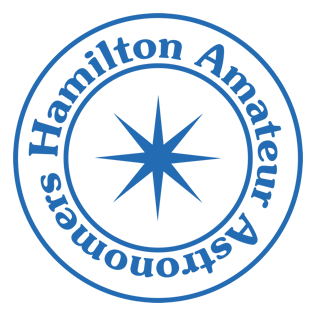Download in PDF format
Welcome to the Messier Observing Program

The Messier Observing Award
The Hamilton Amateur Astronomers offers special recognition in the form of a Messier Observing Program certificate for those that have observed most or all of the Messier objects. To qualify you must be a member of the Hamilton Amateur Astronomers. There are two levels of this award: 75 objects (Silver Level) and the (Gold Level) certificate for successfully observing all 110 objects. To obtain certification you must observe the following rules: The Messier list happens to include most, but not quite all, of the finest objects observable from mid-northern latitudes. There is nothing in the catalog that the owner of a three-inch reflector cannot reach under good observing conditions. Many Messier objects can be seen with binoculars and some with the naked eye.
Rule 1:
Visually observe 75 Messier objects (for the Silver Level) or 110 Messier objects (for the Gold Level) and keep a record of your observations.
Your notes must include:
a. Date (Month, dd, yyyy) and Time of observations (indicate Local time or UT).
b. Object identification.
c. Observing Location (distance from nearest town).
d. Seeing and Transparency.
e. Aperture and focal length of telescope.
f. Type of telescope if using GOTO feature.
g. Eyepiece used and magnification obtained.
h. List any filters used.
i. A description of the Messier object as it appears in the eyepiece.
j. OPTIONAL sketch of the Field of View.
Rule 2:
Have your observing log examined by the H.A.A. Messier Observing Program Coordinator.
Be sure to include your name, mailing address, email address, phone number, Upon successful completion of the requirements a numbered “Silver Level” or “Gold Level” certificate will be presented to you at a future meeting of the HAA. If you choose to receive the certificate by mail, be sure to indicate that choice on your submission form. The certificate will be suitable for framing.
Rule 3:
The ‘Goto” option is yours. If you choose to complete the observing program using electronic aids or an “automated telescope’, an award WILL be issued and a notation will be made on the certificate indicating “Electronic Assistance Used”.
Rule 4:
Since the purpose of the Messier Observing Program is to familiarize the observer with the nature and location of the objects in the sky, the use of an automated telescope which finds the objects without effort on the part of the observer is discouraged. “Automated telescope” also includes the use of digital setting circles where a read-out shows the user directions to follow to locate an object. This also includes the unacceptable use of smartphones that use applications to locate objects in the night sky. The use of the setting circles found on the axis of telescope should also be avoided. In short, only finder scopes, Telrads, or Telrad-like devices are preferred.
The reason……?
The purpose of the “no Go-To” rule is so that you learn the sky and learn how associate a map with the real sky. Learn how to get from here to there without the electronics or the scales. Learn to locate objects without the electronic interface. The knowledge of being able to perform this will always be of benefit in the future.
Also “Messier Marathon” sessions where all the objects are found in one occasion is to be discouraged. An observer cannot truly observe objects in that limited amount of time. Take your time, enjoy yourself, and REALLY see the objects as they were meant to be seen.
This program is meant to be completed using a telescope where multiple magnifications (including a higher power) and filters (if available) can be used.
You are encouraged to not reuse observations from any other Observing Program toward this Observing Program. As time goes by and your experience increases, so will your observing skills. Subsequent observations of the same object should reflect an increase in your observational skills.
Sample observation entry: (Download in Word format)
Date: June 6, 2018________________ Time: 02:15 EDT__________________
Object: Messier 15 _______________ aka: NGC 7078, Mellotte 234________
Object location: Pegasus. 25 degrees above the horizon, 4 degrees NE of Enif.___________
Observing location: Binbrook Conservation Area, Binbrook, ON_______________________
Seeing: __4/5__ Transparency: __7/10__ Conditions: __warm, calm________________
Equipment: Aperture _110 mm_ Focal length: _770 mm_ Type: Orion Duplex Refractor__
Eyepiece: _5 mm__ Barlow: _None_ Filters: None_____ Magnification: __154x__
Object description:
Quite large, 1/10 Field of view. Very bright, magnitude 6.3. Round.
Type IV Open Cluster, moderately rich, moderately concentrated.
2/3 resolved to reveal about 100 brighter stars and many more lesser stars.
No nebulosity noted.
Generally, a large round mass of resolvable stars around a stellar core.
Messier Observing Award Submission Form
Name as you would like to have it appear on the certificate:
_________________________________________________
Phone: _____________________________________
eMail: _____________________________________
- I am submitting my observation information for the:
____ Silver Award (75 objects)
____ Gold Award (Remaining 35 objects)
Please supply the Silver Award certificate number: ________
____ I prefer to have my certificate mailed to me.
Address: _________________________________________
_________________________________________
_________________________________________
_________________________________________
Certification
I certify that I have faithfully followed the rules of this program.
( ___ I have) / (___ I have not) used Electronic Assistance.
_____________________________________________
Click here to download the Observing Order for Messier Objects information file.

